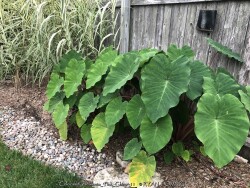

Pink China Hardy Elephant Ear (Colocasia 'Pink China') are typically grown for their large tropical foliage and pink stems. The plants are temperate and subtropical herbaceous perennial bulbs native to areas with a summer monsoon season and dry winter. Pink China Hardy Elephant Ear is hardy outside as a perennial when established and with minimal effort at least up to zone 6a. During the growing season, fertilize, water regularly, and plant in full sun. Plant these bulbs in the ground at least 3-6" deep with 3-4" of mulch. Foliage may look bedwraggled by fall if drought stressed so it is ok to cut back foliage at that time. Plants spread by running ryizomes but are easy to pull up if undesired. They can also be grown as a flowering summer patio plant. If growing as a potted plant and trying to overwinter, allowing the foliage to frost is ok, it will not kill the root system. However, do not allow the pot with rootball to freeze solid or go below 20 degrees for more than a few hours; move into a cold garage or basement over the winter with no watering. Cut back and allow to go dormant and place entire pot back out in April or May with a time-release fertilizer. If digging from the ground in colder zones, just save a big chunk with the dirt intact and place into a large pot in the garage. In our display garden in Lawrence, KS (zone 6a), several established specimens planted over 4-6" deep and mulched 2-3" with wood mulch survived -17 degrees F. During the arctic blast of February, 2021, lows down to -17 degrees F on Feb 16th, 2021 were recorded. The longevity of this cold blast was also impressive: 10 days on a row with highs of 10-15 degrees F or lower, 8 nights of lows in the single digits and negatives, and 36 straight hours of 0 degrees F and mostly lower. This plant can also be used as a marginal aquatic plant growing in shallow water. It can also grow as a bog plant needing constantly moist soil rich in organic matter. As a rain garden plant, it will thrive is a depressed area in the landscape that collects rain water from a roof during spring and summer periods of rain but then go dormant if the water hole dries out completely.
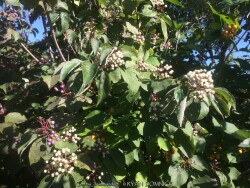

Rough-leaf dogwood is a suckering shrub or rarely a small tree to 15 ft. It is native woodland edges and tall-grass prairie ravines in Kansas olong with the Great Plains and Midwestern regions of the United States. This dogwood is easily recognized by the rough, upper leaf surfaces with flat-topped clusters of creamy-yellow flowers and white fruit on reddish brown or gray twigs. Fall color is purplish-red. Cream-white flowers about 1/4 inch wide, with 4 petals characteristic of all dogwoods. Numerous flowers are in broad clusters at the ends of branches, appearing from April to early June. White fruit then appears in late summer and early fall. A favorite of many wild birds, the fruit is usually stripped clean within a couple weeks. It spreads from root sprouts and provides cover for wildlife and erosion control along ditches. Other uses of roughleaf dogwood include buffer strip around parking lots, highway medians, dust screens along country roads, and naturalizing. It will grow in full sun or full shade in medium to dry soils including dry-shade. However, fall color is quite a bit reduced in full shade. Because of its tolerance for adverse conditions including poor soil and rock, it is often one of the last resort plants that will survive in certain areas. For the home garden, the species is generally too aggressive to mix with other plants especially when irrigated and growing in rich soil. However, in a difficult dry-shade garden, it will thrive, flower, and be relatively tame with little spreading.
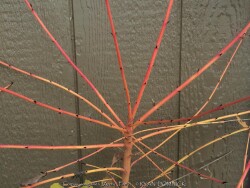

Arctic Sun® Dogwood (Cornus sanguinea 'Arctic Sun') is a new color breakthrough from Proven Winners! Set your winter landscape ablaze with color! Keep your landscape lively even in winter with the glorious yellow, orange, and coral stems of Arctic Sun® dogwood. It performs like the familiar red-twig dogwoods but with unique color that positively glows in the landscape. Tolerant of a very wide range of soil conditions and one of the best ornamental shrubs for shade, Arctic Sun dogwood is an easy choice for nearly effortless color. Top reasons to grow Arctic Sun dogwood: 1.unusual yellow, orange, and coral stems pop in the winter landscape. 2.easy to grow. 3.deer resistant and shade tolerant. Uses Notes: Beautiful in the landscape or a container to add winter interest. Stems may be cut for winter flower arrangements. Maintenance Notes: The best red color appears on one and two year old stems; older stems will turn corky and brown. To maintain a colorful display, you can do one of two things: one, cut the whole plant back to short stubs every other year. Two, cut out one-third of the oldest stems every year. This option is recommended if you planted your Arctic Fire® dogwood to provide coverage. Early spring is the best time to prune. If desired, apply a granular fertilizer formulated for trees and shrubs at pruning time. In Eastern Kansas, this cultivar performs WELL with just about everything nature has to challenge it! Heat and drought are tolerated if in shade or morning sun. Cold tolerance is no problem. No disease or pest problems. Great plant for dry-shade. After 10 years and despite a slow growth rate, it is advisable to rejuvinate this shrub down to the ground as it will reach 5-6 feet tall eventually. Especially effective against dark backgrounds! All Proven Winners® plants are legally propagated, healthy and vigorous, true to name, and tagged with color pictures and growing information.
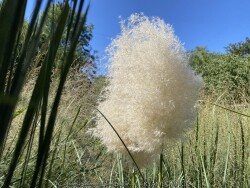

***Description for this plant available with future update!*** Cortaderia selloana 'Blue Bayou' is hardy to zone 6b.


Harry Lauder's Walking Stick / Contorted Filbert, is also known as Corylus avellana 'Contorta'
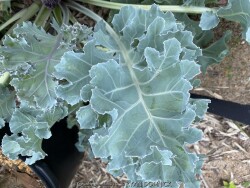

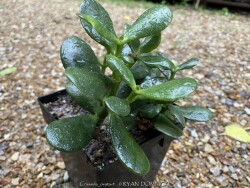

Jade Plant (Crassula ovata) is typically grown in warmer zones. Considered a tropical or succulent in Kansas and used as summer patio plants with white flowers and bright green foliage. Grow in full sun to part sun with optional extra watering during hot weather including that which comes from rainfall. Plants with plenty of time to acclimate will thrive in full sun but be careful not to rush it or sunburning will occur. Generally if moving outside for the summer, allow 2-3 weeks of part shade or morning sun before placing in full sun. Or just keep in part shade or under an overhang. Repotting may or may not be needed depending on how large you want the plant to grow; plants can continue to grow and tolerate extremely root-bound pots but may need wind bracing. Jade Plant can tolerate brief frosts but protect from temperatures below 29 degrees F for more than a few hours. As a permanent house plant, provide bright light and allow the soil to dry between waterings for many years of carefree enjoyment. Potted plants are very low maintenance but the combination of wet and cold will cause problems.
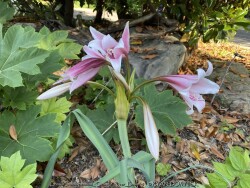

Crinums are tough, long-lived perennial bulbs with strappy leaves and fragrant, funnel-shaped flowers. In areas where the bulbs are hardy, (zones 5/6-10) these plants can reach as much as 4 feet across and bloom all summer. Crinums can live for 200-300 years in the South often found growing in cemeteries and abandoned home sites with little or no attention. The plants are native to southeast Asia often in areas with a summer monsoon and dry winter. They can also be grown as flowering summer patio plants. If growing as a potted plant and trying to overwinter, allowing the foliage to frost is ok, it will not kill the root system. However, do not allow the pot with rootball to freeze solid or go below 20 degrees for more than a few hours; move into a cold garage or basement over the winter with no watering. Cut back and allow to go dormant and place entire pot back out in April or May with a time-release fertilizer. During the growing season, fertilize, water regularly, and place in full sun. You may also plant these in the ground for an enormous tropical effect! It is easy to overwinter these in the ground in Kansas with mulch or no mulch! The trick is to plant them deep: an extra 4-6" deeper than grade or with neck of bulb completely buried. Crinums are extremely adaptable thriving in either in dry or in boggy soils. Crinums are tough, low maintenance bulbs which make them perfect for rain gardens, and although drought-tolerant, crinums bloom more if well-watered. Unlike southern climates, crinums in Kansas need full sun to grow and flower in our shorter growing season. Crinum are more cold hardy than most authorities publish; easily pushing into zone 5 for some varieties. In our trial gardens in Lawrence, KS (zone 6a), the following varieties survived after being mulched 6-12" with leaf mulch to -17 degrees F. (Crinum 'Infusion', Crinum tweedianum, Crinum 'Super Ellen', Crinum x powellii, Crinum 'White Prince') During the arctic blast of February, 2021, lows down to -17 degrees F on Feb 16th, 2021 were recorded. The longevity of this cold blast was also impressive: 10 days on a row with highs of 10-15 degrees F or lower, 8 nights of lows in the single digits and negatives, and 36 straight hours of 0 degrees F and mostly lower. No crinums were lost or harmed during this event! Crinum bulbispermum 'Orange River Basin' is a form of the extremely winter hardy (zone 5) Crinum bulbispermum from South Africa's Orange River area at around 9,000' elevation 'Orange River Basin' forms a lovely non-offsetting clump of glaucous blue foliage and white flowers with pink and magenta throat.
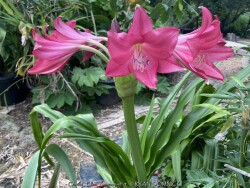

Crinums are tough, long-lived perennial bulbs with strappy leaves and fragrant, funnel-shaped flowers. In areas where the bulbs are hardy, (zones 5/6-10) these plants can reach as much as 4 feet across and bloom all summer. Crinums can live for 200-300 years in the South often found growing in cemeteries and abandoned home sites with little or no attention. The plants are native to southeast Asia often in areas with a summer monsoon and dry winter. They can also be grown as flowering summer patio plants. If growing as a potted plant and trying to overwinter, allowing the foliage to frost is ok, it will not kill the root system. However, do not allow the pot with rootball to freeze solid or go below 20 degrees for more than a few hours; move into a cold garage or basement over the winter with no watering. Cut back and allow to go dormant and place entire pot back out in April or May with a time-release fertilizer. During the growing season, fertilize, water regularly, and place in full sun. You may also plant these in the ground for an enormous tropical effect! It is easy to overwinter these in the ground in Kansas with mulch or no mulch! The trick is to plant them deep: an extra 4-6" deeper than grade or with neck of bulb completely buried. Crinums are extremely adaptable thriving in either in dry or in boggy soils. Crinums are tough, low maintenance bulbs which make them perfect for rain gardens, and although drought-tolerant, crinums bloom more if well-watered. This plant can also grow in standing water or as a potted plant in water gardens. Unlike southern climates, crinums in Kansas need full sun to grow and flower in our shorter growing season. Crinum are more cold hardy than most authorities publish; easily pushing into zone 5 for some varieties. In our trial gardens in Lawrence, KS (zone 6a), the following varieties survived after being mulched 6-12" with leaf mulch to -17 degrees F. (Crinum 'Infusion', Crinum tweedianum, Crinum 'Super Ellen', Crinum x powellii, Crinum 'White Prince') During the arctic blast of February, 2021, lows down to -17 degrees F on Feb 16th, 2021 were recorded. The longevity of this cold blast was also impressive: 10 days on a row with highs of 10-15 degrees F or lower, 8 nights of lows in the single digits and negatives, and 36 straight hours of 0 degrees F and mostly lower. No crinums were lost or harmed during this event!
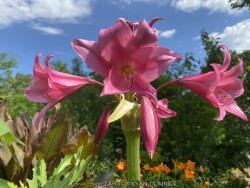

Crinums are tough, long-lived perennial bulbs with strappy leaves and fragrant, funnel-shaped flowers. In areas where the bulbs are hardy, (zones 5/6-10) these plants can reach as much as 4 feet across and bloom all summer. Crinums can live for 200-300 years in the South often found growing in cemeteries and abandoned home sites with little or no attention. The plants are native to southeast Asia often in areas with a summer monsoon and dry winter. They can also be grown as flowering summer patio plants. If growing as a potted plant and trying to overwinter, allowing the foliage to frost is ok, it will not kill the root system. However, do not allow the pot with rootball to freeze solid or go below 20 degrees for more than a few hours; move into a cold garage or basement over the winter with no watering. Cut back and allow to go dormant and place entire pot back out in April or May with a time-release fertilizer. During the growing season, fertilize, water regularly, and place in full sun. You may also plant these in the ground for an enormous tropical effect! It is easy to overwinter these in the ground in Kansas with mulch or no mulch! The trick is to plant them deep: an extra 4-6" deeper than grade or with neck of bulb completely buried. Crinums are extremely adaptable thriving in either in dry or in boggy soils. Crinums are tough, low maintenance bulbs which make them perfect for rain gardens, and although drought-tolerant, crinums bloom more if well-watered. This plant can also grow in standing water or as a potted plant in water gardens. Unlike southern climates, crinums in Kansas need full sun to grow and flower in our shorter growing season. Crinum are more cold hardy than most authorities publish; easily pushing into zone 5 for some varieties. In our trial gardens in Lawrence, KS (zone 6a), the following varieties survived after being mulched 6-12" with leaf mulch to -17 degrees F. (Crinum 'Infusion', Crinum tweedianum, Crinum 'Super Ellen', Crinum x powellii, Crinum 'White Prince') During the arctic blast of February, 2021, lows down to -17 degrees F on Feb 16th, 2021 were recorded. The longevity of this cold blast was also impressive: 10 days on a row with highs of 10-15 degrees F or lower, 8 nights of lows in the single digits and negatives, and 36 straight hours of 0 degrees F and mostly lower. No crinums were lost or harmed during this event!
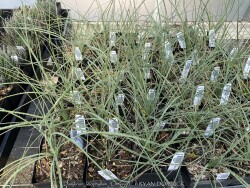

***Description for this plant available with future update!***
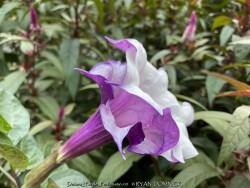

***Description for this plant available with future update!***
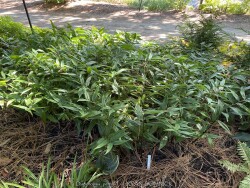

Evergreen Solomon's seal (Disporopsis pernyi) is planted for its evergreen dark green foliage and white flowers. Foliage maintains well all year provided that certain cultural conditions are met. Native to shaded mountain areas in forests, valleys or along streams in southern China, it needs constantly moist soil rich in organic matter avoiding too much clay. If low temperatures hit -10 degrees F, foliage finally dies back to the ground and re-emerges in early spring. Generally this plant can decline after a few years of Kansas climate but is worth a try in perfect soils in well-tended shade gardens. If low temperatures hit -10 degrees F, it may kill an un-mulched plant; protect any zone 6 perennial with thick layer of mulch. Lack of moisture and competition with weeds seem to be an issue but it survives just fine but never gets very dense. This is however, one of the most deep shade tolerant plants available.


Grown for its beautiful bluish-green skin and relatively few spines, San Pedro Cactus () is usually a patio or house plant in Kansas. Because it grows naturally in the Peruvian Andes Mountains at high altitude and with high rainfall, it can withstand temperatures far below that of many other cacti. In the wild, this species is hardy to 15-20 degrees F for short periods of time. Grow in full sun with optional extra watering including that which comes from rainfall. Repotting may or may not be needed depending on how large you want the plant to grow; plants can continue to grow taller and tolerate extremely root-bound pots but may need wind bracing. If repotting, make sure to use a sharp draining medium organic cactus mix with plenty of sand and perlite. To play is safe, potted plants are best moved in before night temperatures get below 45 degrees F. It is important to avoid the combination of wet and cold. Before extreme cold occurs, move to a bright interior window over the winter with no watering and keep above freezing. As a winter house plant, it will look presentable all winter long with just no waterings.(also to prevent lanky winter growth) As a permanent house plant, provide bright light and allow the soil to dry between waterings for many years of carefree enjoyment. Plants grown permanently indoors may begin to elongate stretching for light producing weak new growth. It can be hard to reproduce the intense UV sunlight they need so moving outside for the summer is best. Generally if moving outside for the summer, allow 1-2 weeks of part shade or morning sun before placing in full sun. Plants with time to acclimate will thrive in full sun but be careful not to rush it or sunburning will occur. Potted plants are very low maintenance. I have never seen any insect problems on this plant. The San Pedro cactus contains a number of alkaloids, including the well-studied chemical mescaline. In the US, it is currently legal to cultivate the San Pedro cactus for gardening and ornamental purposes, but not for consumption.
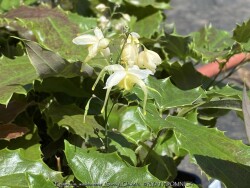

Barrenwort (Epimedium) features compact dainty mounds of green to colored weed-resistant foliage. Wispy flowers appear above emerging foliage in mid-spring. Improved breeding has resulted in many different flower colors even including orange. Semi-evergreen foliage can sometimes look bedraggled by late summer if there is too much overhead watering and humidity. Barrenwort prefers average to dry garden conditions and even thrive and dry shade. Plantings can thrive for decades if in the right spot; there is no such thing as overcrowding for Barrenwort. When planted in mass, growth is slow at first but eventually a cake-like rhizome system will form and completely smother out any weeds and compete well with trees for water and nutrients. While barrenwort can tolerate full sun, they prefer part to full shade. Sun burning is possible with temperatures over 100° and there are better plants to use in hot areas. Due to slow spreading growth, you shouldn't leave very much room in-between barrenwort plants or you will be waiting many years for the patch to fill in. Weeds can be a problem in that open area between plants if spacing is too wide. We recommend 9-12" spacing and use for small nooks in the shade garden. If planning for a larger area, still figure on the tight spacing but allow for a higher budget that you will consider a permanent investment. Barrenwort is a real trooper for the dry shade garden! Sandy Claws Barrenwort (Epimedium wushanense 'Sandy Claws') features long, lance-shaped leaves and spiny margins (not sharp). Newly emerging foliage has dramatic maroon coloring unique to the shade garden. The color mellows to dark green by summer. The cream-colored flowers contrast beautifully with the brilliantly colored foliage. Growth is faster and height is taller at 12-16" Albeit still slow compared to other perennials.
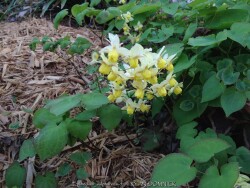

Barrenwort (Epimedium) features compact dainty mounds of green to colored weed-resistant foliage. Wispy flowers appear above emerging foliage in mid-spring. Improved breeding has resulted in many different flower colors even including orange. Semi-evergreen foliage can sometimes look bedraggled by late summer if there is too much overhead watering and humidity. Barrenwort prefers average to dry garden conditions and even thrive and dry shade. Plantings can thrive for decades if in the right spot; there is no such thing as overcrowding for Barrenwort. When planted in mass, growth is slow at first but eventually a cake-like rhizome system will form and completely smother out any weeds and compete well with trees for water and nutrients. While barrenwort can tolerate full sun, they prefer part to full shade. Sun burning is possible with temperatures over 100° and there are better plants to use in hot areas. Due to slow spreading growth, you shouldn't leave very much room in-between barrenwort plants or you will be waiting many years for the patch to fill in. Weeds can be a problem in that open area between plants if spacing is too wide. We recommend 9-12" spacing and use for small nooks in the shade garden. If planning for a larger area, still figure on the tight spacing but allow for a higher budget that you will consider a permanent investment. Barrenwort is a real trooper for the dry shade garden! Epimedium x versicolor 'Sulphureum' is a faster spreading, more robust yellow flowering variety. Albeit still very slow compared to other perennials.
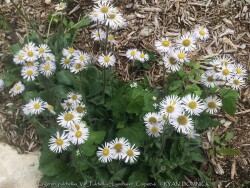

Robin's Plantain / Fleabane, is also known as Erigeron pulchellus var. pulchellus 'Lynnhaven Carpet'
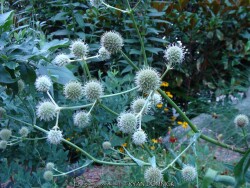

Rattlesnake Master / Eryngium, is also known as Eryngium yuccifolium
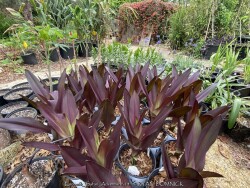

Safari Adventure Pineapple Lily (Eucomis comosa 'Safari Adventure') is typically grown for their wide tropical foliage and pineapple-like flowers. Deep purple foliage contrasts well with many other flower colors. The plants are temperate and subtropical herbaceous perennial bulbs native to areas with a summer wet season and dry winter. Pineapple Lily are hardy outside as a perennial when established and with minimal effort at least up to zone 6a. During the growing season, fertilize, water regularly, and plant in full sun. Plant these bulbs in the ground at least 6-8" deep with 3-4" of mulch to enjoy a wonderful tropical effect! Foliage may look bedwraggled by fall so it is ok to cut back foliage at that time. They can also be grown as a flowering summer patio plant. If growing as a potted plant and trying to overwinter, allowing the foliage to frost is ok, it will not kill the root system. However, do not allow the pot with rootball to freeze solid or go below 20 degrees for more than a few hours; move into a cold garage or basement over the winter with no watering. Cut back and allow to go dormant and place entire pot back out in April or May with a time-release fertilizer. Another more labor intensive way to overwinter pineapple lily is to remove them from the dirt, dust with fungicide, place in box with sawdust, and keep in the refrigerator. We consider this method old-fashioned and too much work but ok if you only want to save a few bulbs. If digging from the ground in colder zones, just save a big chunk with the dirt intact and place into a large pot in the garage.
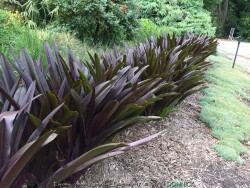

Sparkling Burgundy Pineapple Lily (Eucomis comosa 'Sparkling Burgundy') are typically grown for their wide tropical foliage and pineapple-like flowers. Deep purple foliage contrasts well with many other flower colors. The plants are temperate and subtropical herbaceous perennial bulbs native to areas with a summer wet season and dry winter. Pineapple Lily are hardy outside as a perennial when established and with minimal effort at least up to zone 6a. During the growing season, fertilize, water regularly, and plant in full sun. Plant these bulbs in the ground at least 6-8" deep with 3-4" of mulch to enjoy a wonderful tropical effect! Foliage may look bedwraggled by fall so it is ok to cut back foliage at that time. They can also be grown as a flowering summer patio plant. If growing as a potted plant and trying to overwinter, allowing the foliage to frost is ok, it will not kill the root system. However, do not allow the pot with rootball to freeze solid or go below 20 degrees for more than a few hours; move into a cold garage or basement over the winter with no watering. Cut back and allow to go dormant and place entire pot back out in April or May with a time-release fertilizer. Another more labor intensive way to overwinter pineapple lily is to remove them from the dirt, dust with fungicide, place in box with sawdust, and keep in the refrigerator. We consider this method old-fashioned and too much work but ok if you only want to save a few bulbs. If digging from the ground in colder zones, just save a big chunk with the dirt intact and place into a large pot in the garage. In our display garden in Lawrence, KS (zone 6a), an established specimen planted over 4-6" deep and mulched 2-3" with wood mulch survived -17 degrees F. During the arctic blast of February, 2021, lows down to -17 degrees F on Feb 16th, 2021 were recorded. The longevity of this cold blast was also impressive: 10 days on a row with highs of 10-15 degrees F or lower, 8 nights of lows in the single digits and negatives, and 36 straight hours of 0 degrees F and mostly lower. This eucomis has survived for over 10 years and other extreme cold blasts in the past.


Giant Pineapple Lily (Eucomis pallidiflora ssp. pole-evansii) are typically grown for their wide tropical foliage and giant pineapple-like flowers. Everything about this pineapple lily is large! Bright green foliage upto 3 feet tall contrasts well with many other flower colors. The plants are temperate and subtropical herbaceous perennial bulbs native to areas with a summer wet season and dry winter. Pineapple Lily are hardy outside as a perennial when established and with minimal effort at least up to zone 6a. During the growing season, fertilize, water regularly, and plant in full sun. Plant these bulbs in the ground at least 8-12" deep with 3-4" of mulch to enjoy a wonderful tropical effect! Foliage may look bedwraggled by fall so it is ok to cut back foliage at that time. They can also be grown as a flowering summer patio plant. If growing as a potted plant and trying to overwinter, allowing the foliage to frost is ok, it will not kill the root system. However, do not allow the pot with rootball to freeze solid or go below 20 degrees for more than a few hours; move into a cold garage or basement over the winter with no watering. Cut back and allow to go dormant and place entire pot back out in April or May with a time-release fertilizer. Another more labor intensive way to overwinter pineapple lily is to remove them from the dirt, dust with fungicide, place in box with sawdust, and keep in the refrigerator. We consider this method old-fashioned and too much work but ok if you only want to save a few bulbs. If digging from the ground in colder zones, just save a big chunk with the dirt intact and place into a large pot in the garage. In our display garden in Lawrence, KS (zone 6a), an established specimen planted over 4-6" deep and mulched 2-3" with wood mulch survived -17 degrees F. During the arctic blast of February, 2021, lows down to -17 degrees F on Feb 16th, 2021 were recorded. The longevity of this cold blast was also impressive: 10 days on a row with highs of 10-15 degrees F or lower, 8 nights of lows in the single digits and negatives, and 36 straight hours of 0 degrees F and mostly lower. This eucomis has survived for over 3 years now.
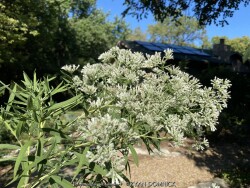

***Description for this perennial available with future update!***


Variegated Fallopia, is also known as Fallopia japonica 'Variegata'
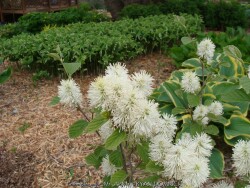

***Shrub descriptions available with future update!***
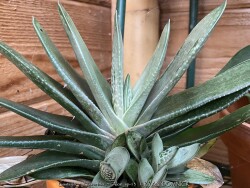

These succulents are usually spineless and grown for their beautiful shapes, color and texture. Gasteria / Haworthia / Aloe are usually grown as small patio or house plants in Kansas. In the wild, some species are hardy to below 20 degrees F. Grow in part sun to full shade with little extra watering except that which comes from rainfall. Repotting may or may not be needed depending on how large you want the plant to grow; plants can continue to grow and tolerate extremely root-bound pots but will eventually need thinned or repotted. If repotting, make sure to use a sharp draining low organic cactus mix with plenty of sand and perlite. To play is safe, potted plants are best moved in before night temperatures get below 45 degrees F. It is important to avoid the combination of wet and cold. Move to a bright interior window over the winter with no watering and keep above freezing. As a winter house plant, it will look presentable all winter long with just a few waterings. As a permanent house plant, provide bright light and allow the soil to dry between waterings for many years of carefree enjoyment. Generally if moving outside for the summer, keep in part to full shade. Some species will acclimate and thrive in full sun but be careful not to rush it or sunburning will occur; move into sun gradually over a few weeks. Potted plants are very low maintenance but avoid too much water or plants will rot.
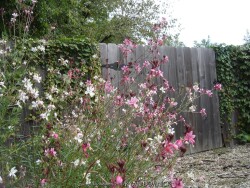

***Description for this perennial available with future update!***
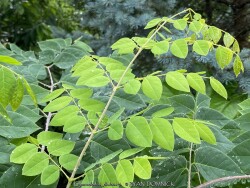

Kentucky Coffeetree, is also known as Gymnocladus dioicus


Elephant's Tongue Plant (Haemanthus albiflos) has attractive exceptionally wide medium green, wide, glossy, curved foliage along with occasional white flowers. It is native to seasonal semi-dry coastal cliffs in South Africa hardy to 23-25 degrees F. It is best used as a houseplant or summer patio plant in Kansas. Place in part to full shade in areas where occasional extra watering can happen including that which comes from rainfall. Repotting may or may not be needed depending on how large you want the plant to grow; plants can continue to grow thicker and tolerate extremely root-bound pots. Potted plants are hardy to at least 30 degrees F for a short time but try not to miss the first light frost. Move into a cold garage, basement, or bright window over the winter with occasional watering. Flowering is more reliable with root-bound plants but rarely occurs. As a winter house plant, it will look presentable all winter long with just a few waterings. As a permanent house plant, provide bright light and allow the soil to dry between waterings for many years (even decades) of carefree enjoyment. Potted plants grow very slow and are very low maintenance needing only old leaves removed once per year. Elephant's tongue is relatively rare and will command a higher price than most other houseplants.
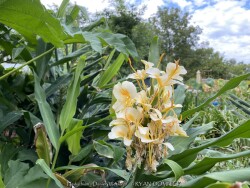

Hardy Ginger (Hedychium) are typically grown for their late summer flowers and vertical wide-leaf foliage. The plants are large tropical and subtropical herbaceous perennials with a rhizomatous rootstock native to areas with a summer monsoon and dry winter. They can be grown as flowering summer patio plants. If growing as a potted plant and trying to overwinter, allowing the foliage to frost is ok, it will not kill the root system. However, do not allow the pot with rootball to freeze solid or go below 20 degrees for more than a few hours; move into a cold garage or basement over the winter with no watering. Cut back and allow to go dormant and place entire pot back out in April or May with a time-release fertilizer. Another more labor intensive way to overwinter cannas is to remove them from the dirt, dust with fungicide, place in box with sawdust, and keep in the refrigerator. We consider this method old-fashioned and too much work but ok if you only want to save a few pieces. If digging from the ground, just save a big chunk with the dirt intact and place into a large pot in the garage. During the growing season, fertilize, water regularly, and place in full sun. You may also plant these in the ground for an enormous tropical effect! It is possible to overwinter these in the ground in Kansas by mulching 6-12" thick over deeply planted rhizomes. New growth may be slightly delayed but probably quick to regain full height. Native habitat for most hedychiums aligns well with our dry winters and warm humid summers. In our trial gardens in Lawrence, KS (zone 6a), we will be testing several varieties in 2022-2023. Famous plantsman, Tony Avent, owner of Plant Delights Nursery in Raleigh, North Carolina, advised us that hedychiums should survive fine here in the ground when mulched like cannas.
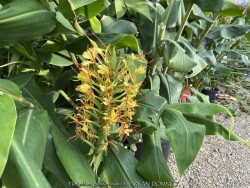

Hardy Ginger (Hedychium) are typically grown for their late summer flowers and vertical wide-leaf foliage. The plants are large tropical and subtropical herbaceous perennials with a rhizomatous rootstock native to areas with a summer monsoon and dry winter. They can be grown as flowering summer patio plants. If growing as a potted plant and trying to overwinter, allowing the foliage to frost is ok, it will not kill the root system. However, do not allow the pot with rootball to freeze solid or go below 20 degrees for more than a few hours; move into a cold garage or basement over the winter with no watering. Cut back and allow to go dormant and place entire pot back out in April or May with a time-release fertilizer. Another more labor intensive way to overwinter cannas is to remove them from the dirt, dust with fungicide, place in box with sawdust, and keep in the refrigerator. We consider this method old-fashioned and too much work but ok if you only want to save a few pieces. If digging from the ground, just save a big chunk with the dirt intact and place into a large pot in the garage. During the growing season, fertilize, water regularly, and place in full sun. You may also plant these in the ground for an enormous tropical effect! It is possible to overwinter these in the ground in Kansas by mulching 6-12" thick over deeply planted rhizomes. New growth may be slightly delayed but probably quick to regain full height. Native habitat for most hedychiums aligns well with our dry winters and warm humid summers. In our trial gardens in Lawrence, KS (zone 6a), we will be testing several varieties in 2022-2023. Famous plantsman, Tony Avent, owner of Plant Delights Nursery in Raleigh, North Carolina, advised us that hedychiums should survive fine here in the ground when mulched like cannas. Butterfly Ginger (Hedychium gardnerianum) is native to the Himalayas in India, Nepal, and Bhutan. The very fragrant pale yellow and red flowers are held in dense spikes above the foliage. Foliage and stems are massive; reaching 6-8 feet tall.
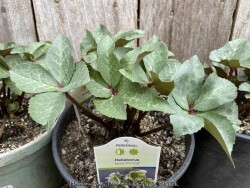

Lenten Rose (Helleborus) are the ultimate dry-shade plant for eastern Kansas landscapes. Most hellebores are native to mountainous wooded regions of Europe with limestone bedrock and calcareous, humus-rich soils. They have everything a gardener might ask for; beautiful spring flowers, dependable dark green foliage, evergreen during winter, appreciation for alkaline soils, and ease of care with very low maintenance. Hellebores are one of the first perennials to start growing in the spring with flowering occurring even with hard freezes. Flowers last incredibly long 2 to 3 months and finally turn greenish in June. No deadheading is needed because the foliage just absorbs the flower stalks as they fade. Summer and fall foliage is dark green, dependable, and pest-free. Evergreen foliage is hardy to about 0°F. If it gets colder than that, hellebores will be deciduous with no detrimental effects. Desirable self-seeding may gently occur around mother plants. Hellebores do have an Achilles heel however; they cannot tolerate wet or poorly drained soils, not even slightly. In areas with too much rainfall or poorly drained soils, foliage diseases and root rot are likely to occur. Hellebores are also not the best choice for full sun, while they will survive, they will get foliage burn in the summer when over 100°F in afternoon sun. With poisonous foliage, these plants resist deer and rabbit browsing. What a great plant for the dry shade garden! There are many improved flowering cultivars to choose from now. Helleborus 'Ivory Prince' is a selection chosen for its quick growing nature. Burgundy-pink buds open to creamy, white flowers that mature with pink highlights in early spring. Blooms face up and outward from the reddish stems over evergreen foliage. Prominent veining on leathery evergreen foliage is showy even when not in bloom. Great in our trial gardens to far.


Lenten Rose (Helleborus) is the ultimate dry-shade plant for eastern Kansas landscapes. Most hellebores are native to mountainous wooded regions of Europe with limestone bedrock and calcareous, humus-rich soils. They have everything a gardener might ask for; beautiful spring flowers, dependable dark green foliage, evergreen during winter, appreciation for alkaline soils, and ease of care with very low maintenance. Hellebores are one of the first perennials to start growing in the spring with flowering occurring even with hard freezes. Flowers last incredibly long 2 to 3 months and finally turn greenish in June. No deadheading is needed because the foliage just absorbs the flower stalks as they fade. Summer and fall foliage is dark green, dependable, and pest-free. Evergreen foliage is hardy to about 0°F. If it gets colder than that, hellebores will be deciduous with no detrimental effects. Desirable self-seeding may gently occur around mother plants. Hellebores do have an Achilles heel however; they cannot tolerate wet or poorly drained soils, not even slightly. In areas with too much rainfall or poorly drained soils, foliage diseases and root rot are likely to occur. Hellebores are also not the best choice for full sun, while they will survive, they will get foliage burn in the summer when over 100°F in afternoon sun. With poisonous foliage, these plants resist deer and rabbit browsing. What a great plant for the dry shade garden! There are many improved flowering cultivars to choose from now. Helleborus 'Sandy Shores' HONEYMOON® is a new series from Walters Gardens hybridizer Hans Hansen. In his breeding work, he selects for plants with notable vigor, showy floral displays with large numbers of blossoms per plant, and rich flower colors.'Sandy Shores' bears 2½-3", single pale apricot flowers with a lovely rosy pink color on the backs.
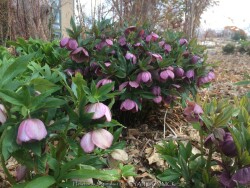

Lenten Rose (Helleborus) is the ultimate dry-shade plant for eastern Kansas landscapes. Most hellebores are native to mountainous wooded regions of Europe with limestone bedrock and calcareous, humus-rich soils. They have everything a gardener might ask for; beautiful spring flowers, dependable dark green foliage, evergreen during winter, appreciation for alkaline soils, and ease of care with very low maintenance. Hellebores are one of the first perennials to start growing in the spring with flowering occurring even with hard freezes. Flowers last incredibly long 2 to 3 months and finally turn greenish in June. No deadheading is needed because the foliage just absorbs the flower stalks as they fade. Summer and fall foliage is dark green, dependable, and pest-free. Evergreen foliage is hardy to about 0°F. If it gets colder than that, hellebores will be deciduous with no detrimental effects. Desirable self-seeding may gently occur around mother plants. Hellebores do have an Achilles heel however; they cannot tolerate wet or poorly drained soils, not even slightly. In areas with too much rainfall or poorly drained soils, foliage diseases and root rot are likely to occur. Hellebores are also not the best choice for full sun, while they will survive, they will get foliage burn in the summer when over 100°F in afternoon sun. With poisonous foliage, these plants resist deer and rabbit browsing. What a great plant for the dry shade garden! There are many improved flowering cultivars to choose from now.


Lenten Rose (Helleborus) is the ultimate dry-shade plant for eastern Kansas landscapes. Most hellebores are native to mountainous wooded regions of Europe with limestone bedrock and calcareous, humus-rich soils. They have everything a gardener might ask for; beautiful spring flowers, dependable dark green foliage, evergreen during winter, appreciation for alkaline soils, and ease of care with very low maintenance. Hellebores are one of the first perennials to start growing in the spring with flowering occurring even with hard freezes. Flowers last incredibly long 2 to 3 months and finally turn greenish in June. No deadheading is needed because the foliage just absorbs the flower stalks as they fade. Summer and fall foliage is dark green, dependable, and pest-free. Evergreen foliage is hardy to about 0°F. If it gets colder than that, hellebores will be deciduous with no detrimental effects. Desirable self-seeding may gently occur around mother plants. Hellebores do have an Achilles heel however; they cannot tolerate wet or poorly drained soils, not even slightly. In areas with too much rainfall or poorly drained soils, foliage diseases and root rot are likely to occur. Hellebores are also not the best choice for full sun, while they will survive, they will get foliage burn in the summer when over 100°F in afternoon sun. With poisonous foliage, these plants resist deer and rabbit browsing. What a great plant for the dry shade garden! There are many improved flowering cultivars to choose from now.
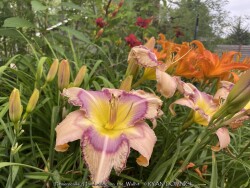

Handwritting on the Wall Multi-colored Daylily, is also known as Hemerocallis 'Handwritting on the Wall'
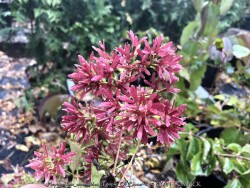

Hang on to your hat - Temple of Bloom® Seven-Son Flower (Heptacodium miconioides 'Temple Of Bloom') is going to blow your mind! We are thrilled to be able to bring this outstanding plant, previously known only by collectors and plant geeks, to everyone in North America. Temple of Bloom seven-son flower is a beautiful, easy to grow small tree which simply can't be matched for year-round beauty. In spring, the handsome leaves emerge, each sporting dramatically deep veins that make the plant stand out in the landscape. As the season progresses, the leaves grow larger and develop a long, twisting tip. Come August, when everything else is winding down, Temple of Bloom seven-son flower is just coming into its own, as it becomes covered in big clusters of fragrant white flowers that hummingbirds and other pollinators flock to. They last for weeks before gracefully falling to the ground to reveal vivid red, fan-like bracts, which make it look like the plant is blooming again in a completely different color. As winter comes and the leaves drop, the plant's elegant frame is revealed, along with amazing light tan peeling bark. Temple of Bloom® seven-son flower is the perfect choice for a special spot in your landscape. Plant it where it can be seen, often, and enjoyed any time of the year. Available in better garden centers in spring 2019. Top reasons to grow Temple of Bloom® seven-son flower: 1. Contribute outstanding interest to your home but needs little care. 2. Flowers in late summer and fall, when other plants are winding down. 3. Peeling bark looks great year-round but is especially memorable in winter. Temple of Bloomtm seven-son flower is at its best as a specimen, thanks to its elegant habit. Though its exact form will depend on how the grower has trained it, it is typically a small, multi-stemmed tree that reaches around 10' tall at maturity. Believe it or not, this beautiful and unusual plant requires essentially no care. It isn't finicky about soils, though it does appreciate regular moisture and good drainage. It will not require any special pruning, though you may prune or train it to your liking if you prefer. If you do prune it, do that in late winter or early spring, as the flower buds begin to set shortly after the plant leafs out. In Eastern Kansas, this cultivar performs WELL with just about everything nature has to challenge it! Heat and drought are tolerated in full sun or shade. Cold tolerance is no problem. No disease or pest problems. All Proven Winners® plants are legally propagated, healthy and vigorous, true to name, and tagged with color pictures and growing information.
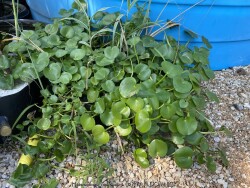

>>>>>This plant can also be used as a marginal aquatic plant growing in shallow water. It can also grow as a bog plant needing constantly moist soil rich in organic matter. As a rain garden plant, it will thrive is a depressed area in the landscape that collects rain water from a roof during spring and summer periods of rain but then go dormant if the water hole dries out completely.
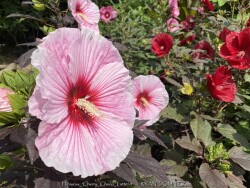

Hardy Hibiscus are US native plants that feature very large single petal flowers sometimes as large as a dinner plate. Colors include white, pink, red, magenta, purple with many different combinations. Foliage can range from green to reddish to dark purplish black. Hardy hibiscus breeding to produce improved cultivars has come a long way in the last 10 or 20 years. Hibiscus emerge later than most other perennials, needing the ground to heat up before growing in May. Hibiscus tolerate a wide range of soil conditions including clay and wetness but prefer rich garden soil. Drought is tolerated with established plants although flowering will be reduced. Generally, the 40 inches of rainfall in Eastern Kansas is sufficient. Full sun is best for optimal foliage coloring, growth habit, and flowers. When used in a landscape, hibiscus brings a tropical feel when flowering and are noticeable from very far away. Combine with hardy bananas (musa basjoo) and other contrasting flowers. Groupings of hibiscus are very effective around water gardens, rain gardens, backyard fences, pollinator gardens, and roadside areas where you only have a second to look when driving by. Modern hibiscus cultivars do not set seed and do not need to be deadheaded like old varieties; the result is continuous blooming from July till September. Cool autumn nights below 50 degrees F initiate beautiful fall foliage colors ranging from red and purple to fiery orange. Maintenance is pretty easy: just cut down dead stocks to the ground at some point in fall or winter. A yearly time-release fertilizer is appreciated from most heavily flowering plants. There are some occasional foliage pests for hibiscuses including leaf miners, grasshoppers, and Japanese beetles but these can be treated. If not treated, it generally won't kill the plant, especially if the plant is otherwise healthy and in good growing conditions. Summerific® 'Cherry Choco Latte' Hibiscus(Hibiscus 'Cherry Choco Latte') is a brand new, long blooming Hibiscus with a smaller size that is more suitable for tighter spaces. This is a recent Walters Gardens Inc. plant introduction. A perfect late summer perennial! Very large, 8-9" three-dimensional flowers are white with intense deep pink veining and a notably large red eye. Attractive dark olive green foliage forms a compact airy clump. All Proven Winners® plants are legally propagated, healthy and vigorous, true to name, and tagged with color pictures and growing information.
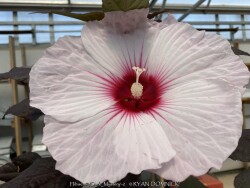

Hardy Hibiscus are US native plants that feature very large single petal flowers sometimes as large as a dinner plate. Colors include white, pink, red, magenta, purple with many different combinations. Foliage can range from green to reddish to dark purplish black. Hardy hibiscus breeding to produce improved cultivars has come a long way in the last 10 or 20 years. Hibiscus emerge later than most other perennials, needing the ground to heat up before growing in May. Hibiscus tolerate a wide range of soil conditions including clay and wetness but prefer rich garden soil. Drought is tolerated with established plants although flowering will be reduced. Generally, the 40 inches of rainfall in Eastern Kansas is sufficient. Full sun is best for optimal foliage coloring, growth habit, and flowers. When used in a landscape, hibiscus brings a tropical feel when flowering and are noticeable from very far away. Combine with hardy bananas (musa basjoo) and other contrasting flowers. Groupings of hibiscus are very effective around water gardens, rain gardens, backyard fences, pollinator gardens, and roadside areas where you only have a second to look when driving by. Modern hibiscus cultivars do not set seed and do not need to be deadheaded like old varieties; the result is continuous blooming from July till September. Cool autumn nights below 50 degrees F initiate beautiful fall foliage colors ranging from red and purple to fiery orange. Maintenance is pretty easy: just cut down dead stocks to the ground at some point in fall or winter. A yearly time-release fertilizer is appreciated from most heavily flowering plants. There are some occasional foliage pests for hibiscuses including leaf miners, grasshoppers, and Japanese beetles but these can be treated. If not treated, it generally won't kill the plant, especially if the plant is otherwise healthy and in good growing conditions. Hibiscus 'Dark Mystery' is a Walters Gardens Inc. introduction. Incredibly dark, wine purple foliage contrasts beautiful with the large 8-9" white flowers. Each flower has a cherry red eye and dark pink veining. Heart-shaped leaves cover the round habit.
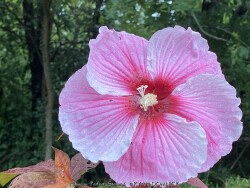

Hardy Hibiscus are US native plants that feature very large single petal flowers sometimes as large as a dinner plate. Colors include white, pink, red, magenta, purple with many different combinations. Foliage can range from green to reddish to dark purplish black. Hardy hibiscus breeding to produce improved cultivars has come a long way in the last 10 or 20 years. Hibiscus emerge later than most other perennials, needing the ground to heat up before growing in May. Hibiscus tolerate a wide range of soil conditions including clay and wetness but prefer rich garden soil. Drought is tolerated with established plants although flowering will be reduced. Generally, the 40 inches of rainfall in Eastern Kansas is sufficient. Full sun is best for optimal foliage coloring, growth habit, and flowers. When used in a landscape, hibiscus brings a tropical feel when flowering and are noticeable from very far away. Combine with hardy bananas (musa basjoo) and other contrasting flowers. Groupings of hibiscus are very effective around water gardens, rain gardens, backyard fences, pollinator gardens, and roadside areas where you only have a second to look when driving by. Modern hibiscus cultivars do not set seed and do not need to be deadheaded like old varieties; the result is continuous blooming from July till September. Cool autumn nights below 50 degrees F initiate beautiful fall foliage colors ranging from red and purple to fiery orange. Maintenance is pretty easy: just cut down dead stocks to the ground at some point in fall or winter. A yearly time-release fertilizer is appreciated from most heavily flowering plants. There are some occasional foliage pests for hibiscuses including leaf miners, grasshoppers, and Japanese beetles but these can be treated. If not treated, it generally won't kill the plant, especially if the plant is otherwise healthy and in good growing conditions. Summerific® 'Perfect Storm' Rose Mallow(Hibiscus 'Perfect Storm') is a Walters Gardens Inc. introduction. A naturally compact selection that works well in large containers. Large 7-8", white flowers with a red eye are produced all over the dense, rounded clump of deep black-purple maple-like leaves. All Proven Winners® plants are legally propagated, healthy and vigorous, true to name, and tagged with color pictures and growing information.
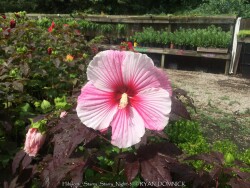

Hardy Hibiscus are US native plants that feature very large single petal flowers sometimes as large as a dinner plate. Colors include white, pink, red, magenta, purple with many different combinations. Foliage can range from green to reddish to dark purplish black. Hardy hibiscus breeding to produce improved cultivars has come a long way in the last 10 or 20 years. Hibiscus emerge later than most other perennials, needing the ground to heat up before growing in May. Hibiscus tolerate a wide range of soil conditions including clay and wetness but prefer rich garden soil. Drought is tolerated with established plants although flowering will be reduced. Generally, the 40 inches of rainfall in Eastern Kansas is sufficient. Full sun is best for optimal foliage coloring, growth habit, and flowers. When used in a landscape, hibiscus brings a tropical feel when flowering and are noticeable from very far away. Combine with hardy bananas (musa basjoo) and other contrasting flowers. Groupings of hibiscus are very effective around water gardens, rain gardens, backyard fences, pollinator gardens, and roadside areas where you only have a second to look when driving by. Modern hibiscus cultivars do not set seed and do not need to be deadheaded like old varieties; the result is continuous blooming from July till September. Cool autumn nights below 50 degrees F initiate beautiful fall foliage colors ranging from red and purple to fiery orange. Maintenance is pretty easy: just cut down dead stocks to the ground at some point in fall or winter. A yearly time-release fertilizer is appreciated from most heavily flowering plants. There are some occasional foliage pests for hibiscuses including leaf miners, grasshoppers, and Japanese beetles but these can be treated. If not treated, it generally won't kill the plant, especially if the plant is otherwise healthy and in good growing conditions. Hibiscus 'Starry Starry Night' is a Walters Gardens Inc. introduction. Incredibly dark, near-black, broad, maple-like leaves form an upright clump in the landscape. Interesting 7-8" flowers are pale pink with darker pink speckling and veining. The flowers are held on bright green carpels, which contrast nicely with the dark foliage. Flowers are produced from the top to the bottom of the plant, rather than only at the top like some older cultivars.
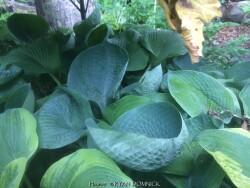

Hosta by far is the most popular and well-known shade plant in the United States. Many thousands of cultivars exist from original species native to China, Japan, and other forested areas in Asia. Hosta foliage arises from a clump-forming root system and is often large and dramatic with many types of variegation. Flowers, born on tall stocks ranging in shades of white and purple, are equally attractive. Hostas grow best in rich, well-drained soils in full to partial shade. In Eastern Kansas with our average 40 inches of average rainfall, plants are drought tolerant if established in moisture-retentive high-quality soil. Dry-shade areas are best avoided. Afternoon sun with temperatures over 95 degrees F but likely burn the tips of hosta foliage rendering them unattractive for the rest of the year. There is no secondary growth by late summer after flowering and after buds have been set for next year. In northern parts of the country, hostas can handle full sun. In the Southern part of their range further South than zone 7, hosta can really struggle through the long summer heat unless conditions are perfect. Rabbits, deer, slugs, and snails can be a problem generally on small or un-established plants. Large-leaf robust varieties seem to outgrow browsing predators better than small dainty varieties. Methods of control are effective ranging from cages to deer repellents. Generally, a large established planting of hostas will be there for decades gradually getting thicker and denser without a need to divide. Many plantings have been in our display garden for 15-20 years with no weeds ever trying to grow in the shade of the foliage. Hosta foliage is susceptible to late spring freezes so try to cover if possible. During the Easter freeze of April, 2007, thousands of hosta were killed to the ground in eastern Kansas but all returned successfully by May from secondary buds. Hosta's newly unfurling foliage is considered edible when cooked like asparagus or eaten raw in salads. Hosta 'Abiqua Drinking Gourd' is a medium (large) puckered, powder-blue leaves with chalky undersides are uniquely upward facing and deeply cupped. White flowers bloom midsummer; very slug resistant.
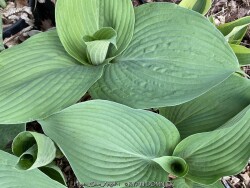

Hosta by far is the most popular and well-known shade plant in the United States. Many thousands of cultivars exist from original species native to China, Japan, and other forested areas in Asia. Hosta foliage arrises from a clump-forming root system and is often large and dramatic with many types of variegation. Flowers, born on tall stocks ranging in shades of white and purple, are equally attractive. Hostas grow best in rich, well-drained soils in full to partial shade. In Eastern Kansas with our average 40 inches of average rainfall, plants are drought tolerant if established in moisture-retentive high-quality soil. Dry-shade areas are best avoided. Afternoon sun with temperatures over 95 degrees F but likely burn the tips of hosta foliage rendering them unattractive for the rest of the year. There is no secondary growth by late summer after flowering and after buds have been set for next year. In northern parts of the country, hostas can handle full sun. In the Southern part of their range further South than zone 7, hosta can really struggle through the long summer heat unless conditions are perfect. Rabbits, deer, slugs, and snails can be a problem generally on small or un-established plants. Large-leaf robust varieties seem to outgrow browsing predators better than small dainty varieties. Methods of control are effective ranging from cages to deer repellents. Generally, a large established planting of hostas will be there for decades gradually getting thicker and denser without a need to divide. Many plantings have been in our display garden for 15-20 years with no weeds ever trying to grow in the shade of the foliage. Hosta foliage is susceptible to late spring freezes so try to cover if possible. During the Easter freeze of April, 2007, thousands of hosta were killed to the ground in eastern Kansas but all returned successfully by May from secondary buds. Hosta's newly unfurling foliage is considered edible when cooked like asparagus or eaten raw in salads. Hosta 'Blue Angel' features giant, heart-shaped blue-green heavily textured leaves under dense hyacinth-like white flowers.
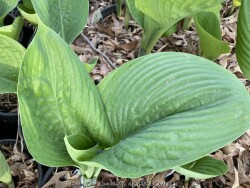

Hosta by far is the most popular and well-known shade plant in the United States. Many thousands of cultivars exist from original species native to China, Japan, and other forested areas in Asia. Hosta foliage arrises from a clump-forming root system and is often large and dramatic with many types of variegation. Flowers, born on tall stocks ranging in shades of white and purple, are equally attractive. Hostas grow best in rich, well-drained soils in full to partial shade. In Eastern Kansas with our average 40 inches of average rainfall, plants are drought tolerant if established in moisture-retentive high-quality soil. Dry-shade areas are best avoided. Afternoon sun with temperatures over 95 degrees F but likely burn the tips of hosta foliage rendering them unattractive for the rest of the year. There is no secondary growth by late summer after flowering and after buds have been set for next year. In northern parts of the country, hostas can handle full sun. In the Southern part of their range further South than zone 7, hosta can really struggle through the long summer heat unless conditions are perfect. Rabbits, deer, slugs, and snails can be a problem generally on small or un-established plants. Large-leaf robust varieties seem to outgrow browsing predators better than small dainty varieties. Methods of control are effective ranging from cages to deer repellents. Generally, a large established planting of hostas will be there for decades gradually getting thicker and denser without a need to divide. Many plantings have been in our display garden for 15-20 years with no weeds ever trying to grow in the shade of the foliage. Hosta foliage is susceptible to late spring freezes so try to cover if possible. During the Easter freeze of April, 2007, thousands of hosta were killed to the ground in eastern Kansas but all returned successfully by May from secondary buds. Hosta's newly unfurling foliage is considered edible when cooked like asparagus or eaten raw in salads. Hosta 'Blue Angel' features giant, heart-shaped blue-green heavily textured leaves under dense hyacinth-like white flowers.
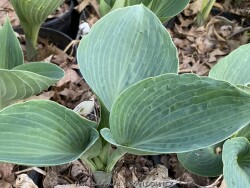

Hosta by far is the most popular and well-known shade plant in the United States. Many thousands of cultivars exist from original species native to China, Japan, and other forested areas in Asia. Hosta foliage arrises from a clump-forming root system and is often large and dramatic with many types of variegation. Flowers, born on tall stocks ranging in shades of white and purple, are equally attractive. Hostas grow best in rich, well-drained soils in full to partial shade. In Eastern Kansas with our average 40 inches of average rainfall, plants are drought tolerant if established in moisture-retentive high-quality soil. Dry-shade areas are best avoided. Afternoon sun with temperatures over 95 degrees F but likely burn the tips of hosta foliage rendering them unattractive for the rest of the year. There is no secondary growth by late summer after flowering and after buds have been set for next year. In northern parts of the country, hostas can handle full sun. In the Southern part of their range further South than zone 7, hosta can really struggle through the long summer heat unless conditions are perfect. Rabbits, deer, slugs, and snails can be a problem generally on small or un-established plants. Large-leaf robust varieties seem to outgrow browsing predators better than small dainty varieties. Methods of control are effective ranging from cages to deer repellents. Generally, a large established planting of hostas will be there for decades gradually getting thicker and denser without a need to divide. Many plantings have been in our display garden for 15-20 years with no weeds ever trying to grow in the shade of the foliage. Hosta foliage is susceptible to late spring freezes so try to cover if possible. During the Easter freeze of April, 2007, thousands of hosta were killed to the ground in eastern Kansas but all returned successfully by May from secondary buds. Hosta's newly unfurling foliage is considered edible when cooked like asparagus or eaten raw in salads. Hosta 'Bulletproof' has extremely thick blue leaves that look good all season: very resistant to slugs and snails. Sport of 'Halcyon'
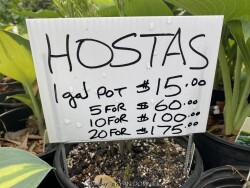

Hosta by far is the most popular and well-known shade plant in the United States. Many thousands of cultivars exist from original species native to China, Japan, and other forested areas in Asia. Hosta foliage arrises from a clump-forming root system and is often large and dramatic with many types of variegation. Flowers, born on tall stocks ranging in shades of white and purple, are equally attractive. Hostas grow best in rich, well-drained soils in full to partial shade. In Eastern Kansas with our average 40 inches of average rainfall, plants are drought tolerant if established in moisture-retentive high-quality soil. Dry-shade areas are best avoided. Afternoon sun with temperatures over 95 degrees F but likely burn the tips of hosta foliage rendering them unattractive for the rest of the year. There is no secondary growth by late summer after flowering and after buds have been set for next year. In northern parts of the country, hostas can handle full sun. In the Southern part of their range further South than zone 7, hosta can really struggle through the long summer heat unless conditions are perfect. Rabbits, deer, slugs, and snails can be a problem generally on small or un-established plants. Large-leaf robust varieties seem to outgrow browsing predators better than small dainty varieties. Methods of control are effective ranging from cages to deer repellents. Generally, a large established planting of hostas will be there for decades gradually getting thicker and denser without a need to divide. Many plantings have been in our display garden for 15-20 years with no weeds ever trying to grow in the shade of the foliage. Hosta foliage is susceptible to late spring freezes so try to cover if possible. During the Easter freeze of April, 2007, thousands of hosta were killed to the ground in eastern Kansas but all returned successfully by May from secondary buds. Hosta's newly unfurling foliage is considered edible when cooked like asparagus or eaten raw in salads. Hosta 'Dream Queen' is a medium; a slightly smaller version of Great Expectations with improved bold variegation. Puckered heart-shaped leaves have wider blue-green margin and creamy yellow centers; white blossoms; excellent substance. Fast grower with more sun tolerance
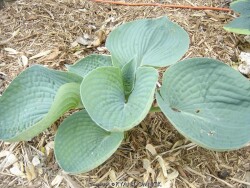

Hosta by far is the most popular and well-known shade plant in the United States. Many thousands of cultivars exist from original species native to China, Japan, and other forested areas in Asia. Hosta foliage arrises from a clump-forming root system and is often large and dramatic with many types of variegation. Flowers, born on tall stocks ranging in shades of white and purple, are equally attractive. Hostas grow best in rich, well-drained soils in full to partial shade. In Eastern Kansas with our average 40 inches of average rainfall, plants are drought tolerant if established in moisture-retentive high-quality soil. Dry-shade areas are best avoided. Afternoon sun with temperatures over 95 degrees F but likely burn the tips of hosta foliage rendering them unattractive for the rest of the year. There is no secondary growth by late summer after flowering and after buds have been set for next year. In northern parts of the country, hostas can handle full sun. In the Southern part of their range further South than zone 7, hosta can really struggle through the long summer heat unless conditions are perfect. Rabbits, deer, slugs, and snails can be a problem generally on small or un-established plants. Large-leaf robust varieties seem to outgrow browsing predators better than small dainty varieties. Methods of control are effective ranging from cages to deer repellents. Generally, a large established planting of hostas will be there for decades gradually getting thicker and denser without a need to divide. Many plantings have been in our display garden for 15-20 years with no weeds ever trying to grow in the shade of the foliage. Hosta foliage is susceptible to late spring freezes so try to cover if possible. During the Easter freeze of April, 2007, thousands of hosta were killed to the ground in eastern Kansas but all returned successfully by May from secondary buds. Hosta's newly unfurling foliage is considered edible when cooked like asparagus or eaten raw in salads. Hosta 'Earth Angel' Giant; this spectacular new sport from Blue Angel has huge blue-green pointed leaves with wide creamy white margins. Thick leaves have good substance and deep attractive ribs. Pale lavender flowers bloom midsummer. Very impressive mature clumps can reach 5' across.
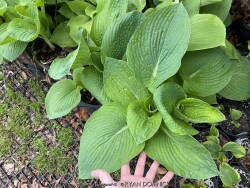

Hosta by far is the most popular and well-known shade plant in the United States. Many thousands of cultivars exist from original species native to China, Japan, and other forested areas in Asia. Hosta foliage arrises from a clump-forming root system and is often large and dramatic with many types of variegation. Flowers, born on tall stocks ranging in shades of white and purple, are equally attractive. Hostas grow best in rich, well-drained soils in full to partial shade. In Eastern Kansas with our average 40 inches of average rainfall, plants are drought tolerant if established in moisture-retentive high-quality soil. Dry-shade areas are best avoided. Afternoon sun with temperatures over 95 degrees F but likely burn the tips of hosta foliage rendering them unattractive for the rest of the year. There is no secondary growth by late summer after flowering and after buds have been set for next year. In northern parts of the country, hostas can handle full sun. In the Southern part of their range further South than zone 7, hosta can really struggle through the long summer heat unless conditions are perfect. Rabbits, deer, slugs, and snails can be a problem generally on small or un-established plants. Large-leaf robust varieties seem to outgrow browsing predators better than small dainty varieties. Methods of control are effective ranging from cages to deer repellents. Generally, a large established planting of hostas will be there for decades gradually getting thicker and denser without a need to divide. Many plantings have been in our display garden for 15-20 years with no weeds ever trying to grow in the shade of the foliage. Hosta foliage is susceptible to late spring freezes so try to cover if possible. During the Easter freeze of April, 2007, thousands of hosta were killed to the ground in eastern Kansas but all returned successfully by May from secondary buds. Hosta's newly unfurling foliage is considered edible when cooked like asparagus or eaten raw in salads. Hosta 'Elegans' is an older variety with giant heart-shaped heavily puckered blue-gray leaves are pest resistant. Near white flowers on short scapes.
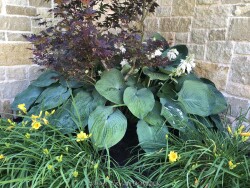

Hosta by far is the most popular and well-known shade plant in the United States. Many thousands of cultivars exist from original species native to China, Japan, and other forested areas in Asia. Hosta foliage arrises from a clump-forming root system and is often large and dramatic with many types of variegation. Flowers, born on tall stocks ranging in shades of white and purple, are equally attractive. Hostas grow best in rich, well-drained soils in full to partial shade. In Eastern Kansas with our average 40 inches of average rainfall, plants are drought tolerant if established in moisture-retentive high-quality soil. Dry-shade areas are best avoided. Afternoon sun with temperatures over 95 but likely burn the tips of hosta foliage rendering them unattractive for the rest of the year. There is no secondary growth by late summer after flowering and after buds have been set for next year. In northern parts of the country, hostas can handle full sun. In the Southern part of their range further South than zone 7, hosta can really struggle through the long summer heat unless conditions are perfect. Rabbits, deer, slugs, and snails can be a problem generally on small or un-established plants. Large-leaf robust varieties seem to outgrow browsing predators better than small dainty varieties. Methods of control are effective ranging from cages to deer repellents. Generally, a large established planting of hostas will be there for decades gradually getting thicker and denser without a need to divide. Many plantings have been in our display garden for 15-20 years with no weeds ever trying to grow in the shade of the foliage. Hosta foliage is susceptible to late spring freezes so try to cover if possible. During the Easter freeze of April, 2007, thousands of hosta were killed to the ground in eastern Kansas but all returned successfully by May from secondary buds. Hosta's newly unfurling foliage is considered edible when cooked like asparagus or eaten raw in salads. Shadowland® 'Empress Wu' is the largest known hosta available! This massive plant forms a gigantic upright mound of huge, thick, dark green leaves topped with pale reddish violet flowers. It will make a fantastic statement in your shade garden! All Proven Winners® plants are legally propagated, healthy and vigorous, true to name, and tagged with color pictures and growing information.


Hosta by far is the most popular and well-known shade plant in the United States. Many thousands of cultivars exist from original species native to China, Japan, and other forested areas in Asia. Hosta foliage arrises from a clump-forming root system and is often large and dramatic with many types of variegation. Flowers, born on tall stocks ranging in shades of white and purple, are equally attractive. Hostas grow best in rich, well-drained soils in full to partial shade. In Eastern Kansas with our average 40 inches of average rainfall, plants are drought tolerant if established in moisture-retentive high-quality soil. Dry-shade areas are best avoided. Afternoon sun with temperatures over 95 degrees F but likely burn the tips of hosta foliage rendering them unattractive for the rest of the year. There is no secondary growth by late summer after flowering and after buds have been set for next year. In northern parts of the country, hostas can handle full sun. In the Southern part of their range further South than zone 7, hosta can really struggle through the long summer heat unless conditions are perfect. Rabbits, deer, slugs, and snails can be a problem generally on small or un-established plants. Large-leaf robust varieties seem to outgrow browsing predators better than small dainty varieties. Methods of control are effective ranging from cages to deer repellents. Generally, a large established planting of hostas will be there for decades gradually getting thicker and denser without a need to divide. Many plantings have been in our display garden for 15-20 years with no weeds ever trying to grow in the shade of the foliage. Hosta foliage is susceptible to late spring freezes so try to cover if possible. During the Easter freeze of April, 2007, thousands of hosta were killed to the ground in eastern Kansas but all returned successfully by May from secondary buds. Hosta's newly unfurling foliage is considered edible when cooked like asparagus or eaten raw in salads. Hosta 'Halcyon' is a medium height cultivar. It features spearhead-shaped chalky-blue leaves with heavy ribbing and pale lavender flowers. Thick substance, pest resistant, tolerates partial sun.